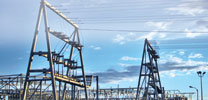

“Possibly the only project of this nature in the whole world, and definitely the only project in Brazil that uses mobile DVRs in this fashion,” is how Alvaro de Souza, CCTV manager at VMI (the company in charge of designing this security project) aptly defined this revolutionary Brazilian security solution.
In 2010, Rio Grande Energia (RGE) decided a change was in order for its electricity stations. These stations, responsible for the electrical distribution throughout the north-northeast portion of Rio Grande do Sul, serve 262 municipalities – representing 51% of all counties in this Brazilian state.
Previously, security at all electricity substations was comprised of an intrusion and alarm system. In turn, these alarm systems were tied into various support stations to alert technical workers of a possible situation.
Yet, while straightforward enough, these support stations are generally located a great distance from the outlying electricity substations. In essence, if an alarm were to go off, a maintenance worker would have to place their normal work duties on the backburner, and literally drive for hours to determine the nature of the incident – a waste of both time and company resources.
Additionally, while an alarm might actually relate to a legitimate security threat, it was far more often an everyday occurrence – such as grazing animals wandering too near the facility – that triggered the response. Unfortunately, due to the distance between substations and support points, and the fact that these are all located in a rural environment; no infrastructure was in place to support technology such as a live Internet feed. As such, technical workers were forced to spend an increasingly large percentage of their workdays chasing nothing. Both RGE and their employees agreed something needed to be done.
What was to be done?
This is the question RGE executives asked themselves. The cost of building the infrastructure necessary for Internet access, from the ground up, was cost prohibitive – to say the least. From a conventional security standpoint, the options of providing real-time video… the vital component in order to eliminate this growing time nuisance… were few and far between.
Enter Alvaro de Souza and VMI. After considerable time spent pondering possibilities, and ruling others out, Souza chose an inventive path. With the help of Hikvision security technology, it was indeed possible to supply these support stations with the necessary real-time video of each-and-every electricity substation. The trick was in the DVR, or more specifically, Hikvision’s DS-8104HMI-B Mobile DVR with 3G module.
“We have always had great faith in Hikvision technology. But, this project represented a leap from the norm, so we extensively tested the DS-8104HMI-B to make sure it could provide quality images over a 3G network for employees at distant substations to evaluate. Our tests proved the usage of Hikvision mobile DVRs would be a great solution to this sticky problem,” Souza noted.
For this project, the key was to reverse the general process: use the DS-8104HMI-B Mobile DVR as a stationary DVR unit. In doing so, the thorny problem of installing expensive fibre-optic cable or cable lines was completely sidestepped.
Yet, where one major problem was solved, another presented itself. “Brazil has an unfortunate history of not always having the most stable 3G wireless network. Sometimes problems do arise,” Souza explained. As such, if any power outages – or other network issues arose – this entire 3G solution could collapse. Yet this problem was easily remedied by the DS-8104HMI-B 3G’s ability to store a backup at the location site. Thus, if any 3G network problems were to occur; one need only travel to the actual site to recover security footage.
The DS-8104HMI-B Mobile DVR is able to accomplish all of these requirements through several features; such as H.264 video compression, up to 4CIF resolution recording, two pluggable 2,5-inch SATA HDDs, a patented hard disk vibration-proof and bracing technology, and a built-in 3G (WCDMA/cdma2000) module (optional).
The final piece
While Hikvision’s mobile DVRs solved the problem of connectivity, another piece still remained: the eyes of the solution. For Souza, compared to overcoming a lack of Internet capability with Brazil’s existing 3G network, this was a proverbial piece of cake: “I immediately knew what camera would be best for this solution – Hikvision’s DS-2AF1-617-B Speed Dome. Due to the 128X wide dynamic range and 36 zoom magnification, this was the perfect camera to give employees at these far-off support stations the tools to see if something constituted an actual threat.”
Souza continued, “Furthermore, the DS-2AF1-617-B provides an angle of view to cover 360 degrees – as far as we could ask this equipment to go. Now when the alarm sounds, real-time video through these Hikvision cameras will allow support-station technicians to make an accurate – and resource saving – optimal choice.” Additionally, Souza noted this speed dome works especially well in a ‘low-light environment’ due to its true day/night imaging.
Further features, such as a 128X wide dynamic range, 540 TVL high resolution, 3D intelligent positioning function, 3D digital noise reduction, and an IP66 rating give this camera the tools to secure every RGE electricity station providing power to this portion of Brazil.
For more information contact Hikvision, +86 571 8700 6060, [email protected], www.hikvision.com
| Tel: | +27 10 085 8300 |
| Email: | [email protected] |
| www: | www.hikvision.com/africa/ |
| Articles: | More information and articles about Hikvision South Africa |
© Technews Publishing (Pty) Ltd. | All Rights Reserved.